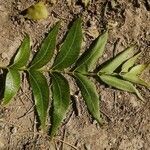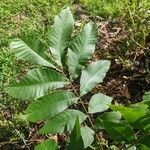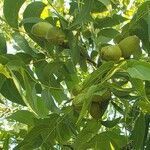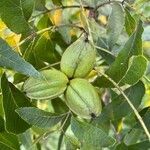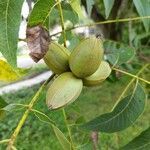A large tree up to 55 m high. Trees lose their leaves during the year. Branches extend upwards giving the tree an open, rounded crown and the tree can be 8 m wide. The stem is stout and erect. The bark is grey and furrowed with an ornamental appearance. The leaves are bright green, compound leaves. The leaves are 30-50 cm long. The leaves are made up of 7-10 leaflets. These are long and curved sword shaped. The leaflets have short leaf stalks. The leaves turn yellow before they fall. The flowers are greenish and small. Trees normally have male and female flowers separately on the same plant, but because the flower parts develop at separate times, cross pollination normally occurs. Male flowers grow on catkins near the branches on the previous year's growth. The fruit are dark brown nuts that are carried in clusters of 4-12. The fruit can be 6 cm long. It has a thin shell. At maturity the fruit splits into 4 valves and reveal the smooth brown kernel. There are many cultivated varieties.
Trees to 50 m tall. Terminal buds with 4 or more false-valved scales, yellowish brown. Leaves 25-35 cm; petiole 4-8 cm, glabrous or glabrescent; rachis generally glabrous or glabrescent; leaflets (7 or)9-13(-17), lateral ones shortly petiolulate or sessile, blade ovate-lanceolate to elliptic-lanceolate or long elliptic, 7-18 × 2.5-4 cm, with scattered, peltate scales, abaxially pubescent or glabrescent, base oblique, broadly cuneate or subrounded, apex acuminate; terminal petiolule 5-25 mm. Male spikes 8-14 cm; peduncle nearly absent. Anthers sparsely pilose. Nuts ovoid-ellipsoid, 3-5 × 2-3 cm; husk without prominent wings; shell without longitudinal ridges, ca. 1 mm thick, 2-chambered at base, lacunae present. Fl. May, fr. Sep-Nov. 2n = 32, rarely 64.
Bark deeply furrowed; lfls 11–17, oblong-lanceolate, the lateral conspicuously falcate, the terminal commonly on a stalk 2–4 mm; frs in spikes of 3–10, ellipsoid or cylindric, 3–5 cm, narrowly winged to the base; nut ellipsoid or cylindric, terete, 2.5–4 cm, brown, smooth, short-pointed; kernel edible, each half barely notched at the tip; 2n=32. Wet alluvial forests; sw. O. to Io. and e. Kans., s. to Ala., Tex., and N. Mex. (C. pecan) C. ×brownii Sarg. is a hybrid with C. cordiformis; C. ×nussbaumeri Sarg., with C. laciniosa; C. ×lecontei Little, with C. aquatica; and C. ×schneckii Sarg., with C. tomentosa.
